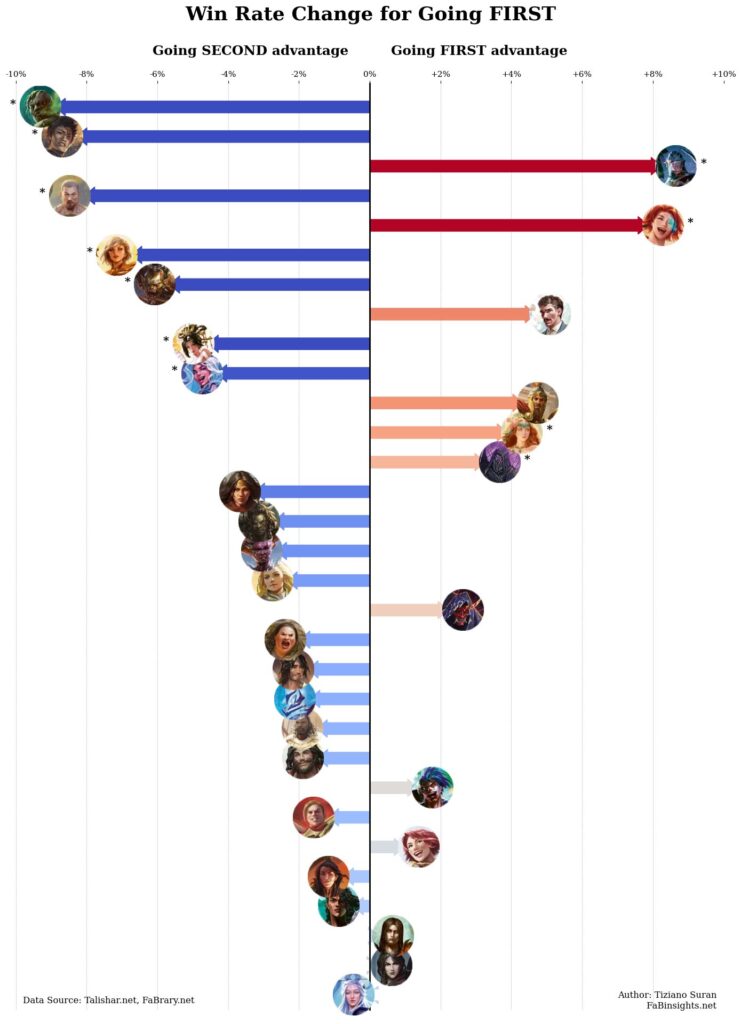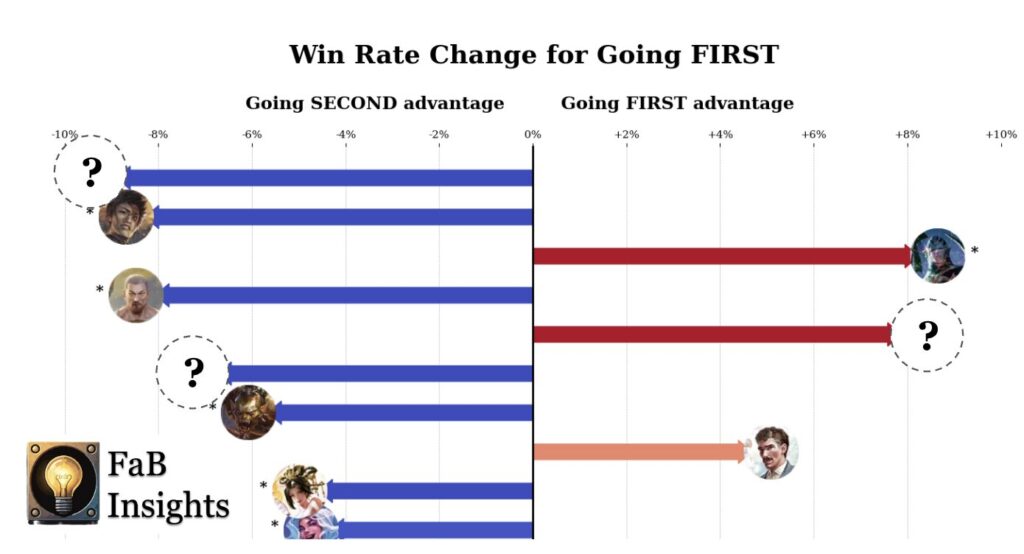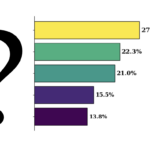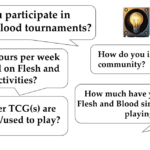Can the choice to start first or second significantly affect the outcome of a match? Many players have asked themselves this question, and seasoned veterans of Flesh and Blood have built up a solid intuition about which heroes thrive on taking the first move and which ones prefer to go second. But how much does it actually matter? By diving into hard data on each hero’s performance based on starting order, we can determine whether some heroes systematically gain a measurable advantage by going first or second—and just how big that advantage is. Knowing which heroes gain the most from a particular start order can help players make smarter decisions. With insights into each hero’s strengths and weaknesses, you’ll be equipped to tailor your starting choice to maximize your hero’s potential—or even to counter an opponent’s plans.
Overview of Methodology (technical)
To measure each hero’s starting advantage, I conducted a paired-samples t-test comparing each hero’s win rates when starting first versus starting second from over a hundred thousand CC games from Talishar.net (made available via FaBrary.net) from the month of October 2024.
The test evaluates whether the differences in performance between starting positions are statistically significant for each hero. A t-statistic is generated, and associated with a p-value. Heroes with a p-value below 0.05 show a statistically significant preference for a particular starting position, meaning their performance differences are unlikely due to chance alone.
Visualizing the Data
The plot displays each hero’s win rate change when starting first, with values expressed as a percentage difference in win rate between starting first and starting second.

- Leftward arrows (blue) indicate that a hero benefits more from starting second. These heroes generally capitalize on reactive playstyles or immediate aggression. The further left an arrow extends, the greater the benefit of going second.
- Rightward arrows (red) show a preference for starting first. Heroes with these arrows often gain an advantage from setup-oriented actions—such as placing items, creating auras, or gaining life—that allow them to secure a tempo lead for future turns. Arrows further to the right indicate a larger win rate boost when starting first.
- Arrow length represents the strength of each hero’s starting position advantage. Longer arrows indicate a more pronounced difference, while shorter arrows imply a smaller impact based on starting order.
- Statistical significance is marked with an asterisk (*) next to the hero’s portrait. The advantage of these heroes is unlikely due to chance (i.e. it is unlikely to be noisy data looking like a pattern).
This visualization offers a quick, data-backed reference for players, helping them understand each hero’s starting preference and adjust strategies based on their hero’s (and their opponent’s) preferred play style. how the starting position impacts a hero’s performance, making it easier for players to adapt strategies based on their hero’s preference.
Heroes with a Strong Advantage for Starting First
Certain heroes show a statistically significant advantage when they start first, often due to their reliance on setup actions, such as creating auras or building items. These setups allow them to establish early control, enabling more efficient turns later in the game.
- Dash I/O and Vynnset, Iron Maiden display the strongest preference for starting first, gaining up to an 8% performance boost when they do so. Dash I/O, known for her aggressive deck style, leverages the first turn to establish crucial items, making her an exception among aggressive heroes who typically favor going second.
- Verdance, Thorn of the Rose and Viserai, Rune Blood also benefit from going first, enjoying up to 4% performance gains. Early setup allows them build up value from the get go.
Heroes with a Strong Advantage for Starting Second
Other heroes perform better when they go second, often because their strategies are more aggressive or reactive. By starting second, these heroes can respond to their opponent’s moves with offensive pressure, seizing opportunities for high-impact plays that disrupt their opponents.
- Prism, Awakener of Sol and Riptide, Lurker of the Deep have up to a 9% performance increase when starting second, indicating that their playstyles are optimized when reacting to the opponent’s setup.
- Kayo, Armed and Dangerous and Aurora, Shooting Star show similar trends, with a 4-5% increase in performance from going second. These heroes can gain momentum by responding effectively to the opponent’s initial moves, often disrupting their rhythm and gaining a stronger position on the board.
Heroes with No Significant Advantage
Several heroes show no statistically significant advantage when it comes to starting order.
- Arakni, Huntsman and Katsu, the Wanderer perform similarly regardless of their starting position, demonstrating flexibility in adapting to early or reactive turns.
- Other heroes, such as Kano, Dracai of Aether and Bravo, Showstopper, also show no significant preference. These heroes’ balanced abilities make them adaptable, suggesting they are equally effective no matter the starting position.
This flexibility enables players using these heroes to focus more on gameplay execution and deck strategy rather than worrying about a specific starting order.
Implications for Strategy
This data provides valuable insights for competitive players aiming to optimize their strategy:
- Deck and Play Style Adjustments: Heroes with a strong advantage for starting first, such as Dash I/O and Vynnset, can prioritize early setup and control-oriented plays. In contrast, heroes like Prism and Riptide may focus on reactive and aggressive tactics when they go second, aiming to minimize the impact of their opponent’s initial moves.
- Starting Order Decisions: Heroes in the “no advantage” category, like Katsu or Bravo, allow players to make starting decisions based on matchup specifics rather than a fixed preference. This adaptability can be a distinct advantage in tournaments where matchups vary and starting position is often random.
- Tournament Preparation: Understanding starting order preferences allows players to tailor their strategies to their hero’s strengths. In settings where starting position isn’t guaranteed, being aware of these trends helps players anticipate potential outcomes and adjust their tactics accordingly.
Conclusion
The choice to start first or second in Flesh and Blood isn’t just a formality—it’s a strategic decision that can impact the game’s outcome from the very first turn. Our analysis reveals how certain heroes gain clear advantages depending on their starting position, while others remain versatile and perform consistently regardless of who goes first. By understanding these dynamics, players can make more informed decisions not only to capitalize on their own hero’s strengths but also to anticipate and potentially counter the advantages of their opponents.
This data-driven approach not only enhances competitive gameplay but also encourages players to adapt their strategies based on matchup specifics. Whether you’re a veteran or new to the game, factoring in both your hero’s and your opponent’s starting preferences can provide a meaningful edge, helping you to navigate matchups with greater precision and insight.



